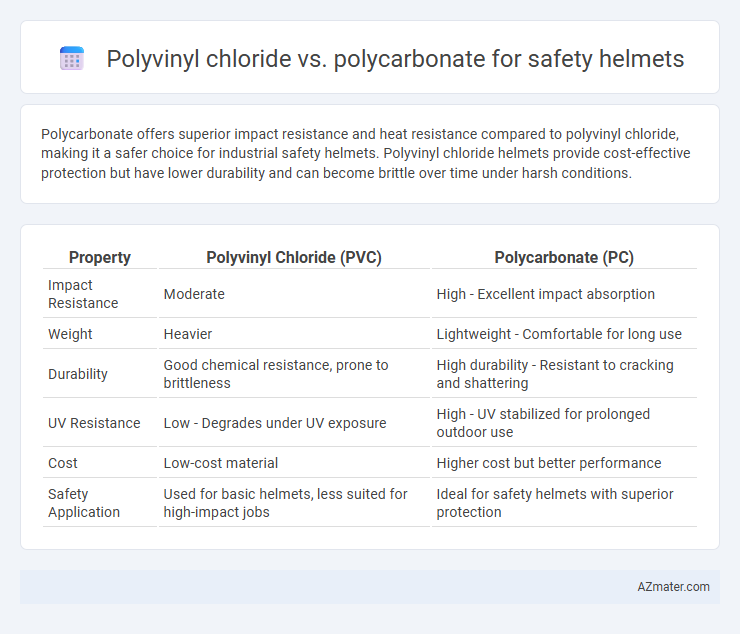Polycarbonate offers superior impact resistance and heat resistance compared to polyvinyl chloride, making it a safer choice for industrial safety helmets. Polyvinyl chloride helmets provide cost-effective protection but have lower durability and can become brittle over time under harsh conditions.
Table of Comparison
| Property | Polyvinyl Chloride (PVC) | Polycarbonate (PC) |
|---|---|---|
| Impact Resistance | Moderate | High - Excellent impact absorption |
| Weight | Heavier | Lightweight - Comfortable for long use |
| Durability | Good chemical resistance, prone to brittleness | High durability - Resistant to cracking and shattering |
| UV Resistance | Low - Degrades under UV exposure | High - UV stabilized for prolonged outdoor use |
| Cost | Low-cost material | Higher cost but better performance |
| Safety Application | Used for basic helmets, less suited for high-impact jobs | Ideal for safety helmets with superior protection |
Introduction to Safety Helmet Materials
Polyvinyl chloride (PVC) and polycarbonate (PC) are widely used materials in safety helmet manufacturing due to their unique properties. PVC offers excellent chemical resistance and affordability, making it suitable for general industrial helmets, while polycarbonate provides superior impact resistance and optical clarity, ideal for helmets requiring higher protection standards. Understanding the material characteristics helps in selecting the appropriate helmet for specific safety requirements and work environments.
Overview of Polyvinyl Chloride (PVC)
Polyvinyl Chloride (PVC) is a widely used thermoplastic polymer known for its durability, chemical resistance, and affordability, making it a common choice in safety helmet manufacturing. PVC's rigidity and impact resistance provide adequate protection against low to moderate impact forces, while its lightweight nature enhances wearer comfort during extended use. Though less heat resistant than polycarbonate, PVC helmets offer cost-effective safety solutions in industrial and construction environments where chemical exposure is a concern.
Overview of Polycarbonate (PC)
Polycarbonate (PC) offers superior impact resistance and high tensile strength compared to Polyvinyl chloride (PVC) when used in safety helmets, making it an ideal choice for environments requiring enhanced protection. Its inherent clarity and UV resistance also contribute to better visibility and longer durability under harsh conditions. Lightweight and thermally stable, polycarbonate helmets provide comfort without compromising safety standards in industrial and construction settings.
Mechanical Strength Comparison
Polycarbonate exhibits significantly higher mechanical strength compared to polyvinyl chloride, making it more resistant to impact, cracking, and deformation under stress. This superior durability ensures enhanced protection and longevity in safety helmets used in high-risk environments. Polycarbonate's higher tensile strength and impact resistance contribute to its widespread preference for industrial and construction safety gear.
Impact Resistance: PVC vs Polycarbonate
Polycarbonate offers significantly higher impact resistance compared to polyvinyl chloride (PVC), making it a preferred material for safety helmets in high-risk environments. PVC provides moderate impact absorption but tends to be more rigid and brittle under extreme force, which can compromise helmet durability. Polycarbonate's superior toughness and ability to dissipate energy upon impact enhance wearer protection against potential head injuries.
Weight and Comfort Analysis
Polycarbonate safety helmets are significantly lighter than polyvinyl chloride (PVC) helmets, enhancing wearer comfort by reducing neck strain during extended use. Polycarbonate offers superior impact resistance with a thinner shell compared to the thicker, heavier PVC counterparts, improving breathability and ease of movement. The lightweight nature of polycarbonate contributes to better ventilation and long-term comfort, making it the preferred choice for safety helmets.
Chemical Resistance and Environmental Durability
Polyvinyl chloride (PVC) offers superior chemical resistance against acids, alkalis, and oils, making it ideal for safety helmets exposed to harsh industrial chemicals. Polycarbonate (PC) provides excellent environmental durability, with high impact resistance and UV stability, essential for prolonged outdoor use. While PVC excels in resisting corrosive substances, polycarbonate ensures longer-lasting performance under extreme weather conditions.
Cost and Availability Factors
Polyvinyl chloride (PVC) helmets are generally more cost-effective due to lower raw material and manufacturing expenses, making them widely accessible in budget-conscious markets. Polycarbonate helmets, while more expensive upfront, offer superior durability and impact resistance, which can justify higher initial costs in safety-critical applications. Availability of PVC is broad globally, but polycarbonate helmets might be limited in certain regions due to specialized production requirements and higher price points.
Safety Standards and Certification
Polyvinyl chloride (PVC) and polycarbonate (PC) helmets differ significantly in meeting safety standards and certifications such as ANSI Z89.1, EN 397, and CSA Z94.1, with polycarbonate helmets often exceeding impact resistance and penetration tests due to their high tensile strength and elasticity. PVC helmets may comply with basic safety standards but generally lack the advanced certification for high-impact or industrial environments that polycarbonate helmets commonly achieve.
Conclusion: Choosing the Right Material for Safety Helmets
Polycarbonate offers superior impact resistance and clarity, making it ideal for safety helmets requiring high durability and visibility. Polyvinyl chloride (PVC) provides affordability and good chemical resistance but lacks the robust impact strength of polycarbonate. Selecting the right material depends on the balance between cost, protection level, and specific use-case requirements in safety applications.

Infographic: Polyvinyl chloride vs Polycarbonate for Safety helmet
 azmater.com
azmater.com